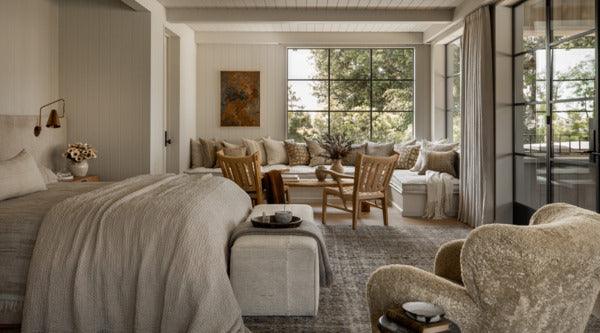Gifting has never been easier
Perfect if you're short on time or are unable to deliver your gift yourself. Enter your message and select when to send it.

Cart
Your cart is empty
As a lighting designer with three years of experience studying trends in interior design and home decor, I believe the future of lighting involves integrating sustainable materials like rattan pendants to create an eco-friendly ambiance.
In this article, I'll analyze current developments in sustainable lighting, the benefits of rattan pendants, and how green design will shape the future of residential and commercial spaces.
Sustainable lighting aims to reduce environmental impact through energy efficiency, renewable energy sources, and eco-friendly materials like rattan. As per my analysis, the key benefits are included below.
Energy-optimized lighting design can reduce electricity usage by 40-80% compared to conventional options, according to Mettas, C., Evagorou, E., Agapiou, A., & Hadjimitsis, D. (2020). For example, LED lighting coupled with smart sensors cuts lighting loads by half or more.

This makes energy-efficient lighting very economical from a life cycle cost perspective. Source: Sustainable Jungle [1]
These deep energy savings add substantial cost reductions in monthly power bills. Commercial facilities save thousands in operating expenses, while households see a few hundred dollars in annual savings.
Efficient lighting is estimated to help avoid over tons of carbon emissions globally. Upgrading old fluorescent and incandescent bulbs to LEDs and right-sizing lighting layouts prevent significant greenhouse gas pollution.
Integrating renewables like solar further mitigates emissions from fossil fuel-based electricity. This is a key aspect of designing carbon-neutral buildings.
Beyond cost and emissions, sustainable lighting also boosts occupant health, comfort, and productivity. Solutions like biodynamic lighting and extensive daylight exposure help reinforce natural circadian rhythms.

Harnessing natural lighting to enhance both mental and physical well-being. Source: Perfect Picture Lights [2]
This reduces headaches and eyestrain while improving mood and cognitive function. People-centric lighting design considers how illumination impacts human biology and behaviors. The goal is to balance visibility, comfort, health, and efficiency for superior indoor environments.
Green technology and renewable materials have also made sustainable lighting extremely adaptable and aesthetic. Contemporary fixtures use recycled metals, bioplastics, renewable rattan, and bamboo to achieve unique shapes and textures.
At the same time, lighting remains durable and stable. Designers now have abundant options to craft stylish lighting arrays tailored to project needs. The days of utilitarian CFLs as the poster child of energy-efficient lighting are long gone!
In my professional opinion as a lighting designer, rattan pendants make an excellent sustainable lighting choice for modern interiors.
As an increasingly popular light fixture, rattan pendants stand out for their natural warmth and artisanal craftsmanship. The organic texture of rattan brings the outdoors in while supporting energy efficiency goals.
Rattan is one of the most renewable materials available today. The fast-growing vines offer durable fibers that can be sustainably harvested without harming the plant. And rattan ages beautifully in the right indoor environment – it develops an elegant patina over decades of use.

Rattan lighting fixtures far outlast most metal or plastic options. Source: Gordon Bullard & Company [3]
In my view, living spaces feel more welcoming and cozy with visible natural elements. From the varied brown hues to intricate hand-woven textures, rattan pendants inject organic artistry into modern minimalist environments. They lend spaces a down-to-earth elegance.
Additionally, rattan offers useful structural properties for lighting fixtures. Due to its tubular shape and porous weave, rattan provides good ventilation for bulb heat dissipation.
This increases the life of the light source compared to fully enclosed lamp housings. Such passive airflow optimizations support the environmental cause by extending equipment lifespan.
The light weight of rattan fixtures cuts transportation emissions too. Lighter packages mean fuel savings in the supply chain. So rattan checks all the boxes for sustainable lighting materials.
Rattan also wins big on versatility. Malleable rattan fibers let artisans craft pendant fixtures of varied shapes, sizes and silhouettes. From domed globes to conical wraparounds, design choices are extensive. Colors range from blond and caramel hues to deeper espresso tones.

In the current market, there is an abundance of rattan pendant light designs, offering you ample choices to explore. Source: Rattan Homecraft [4]
Tiered cascade designs provide showstopper visuals. With options galore, rattan lamps enhance any interior style - from modern and tropical to bohemian and cottage themes. Their textural elegance just as easily transforms industrial lofts as beach homes.
Sustainable lighting forms a keystone element of green building and interior design. It intersects with energy efficiency goals and renewable energy adoption for net-zero structures:
The starting point is optimizing lighting to minimize electricity demands. With careful layouts and right-sized fixtures, lighting loads can decrease by 50-80%.
For example, new construction projects can be designed from the outset with predominantly daylighting. Supplemental LED lighting then activates based on occupancy and ambient light conditions. Such strategies create ultra-low-energy spaces matching power generation.
Thoughtful lighting design also benefits thermal management. Reduced internal gains from efficient lighting cut air conditioning needs. Cooling loads drop by 5-20% depending on climate. This amplifies the sustainability dividends beyond just electrical savings.
Once lighting power needs are minimized, renewable energy integration helps achieve carbon-neutral operation. Solar photovoltaics are particularly synergistic to meet daytime illumination loads.

It also enables healthy spaces through biophilic elements like rattan pendants. Source: Finding Sea Turtles [5]
Excess solar energy can also support smart battery storage for overnight lighting. Intelligent controls balance renewable supply and deferred lighting demand.
For spaces with round-the-clock occupancy, like hospitals, wind energy, and fuel cells provide inexpensive clean power. With smart grid connectivity, buildings can tap into grid green energy too, when local generation falls short. Prioritizing renewables right-sizes power needs for eco-friendly lighting.
Sustainable materials also reinforce the eco-friendly attributes of green lighting solutions. Locally available natural rattan, bamboo, and recycled plastics minimize embodied emissions from manufacturing and transportation.
Responsibly sourced wood brings biophilic warmth. These renewable resources offer durability and aesthetically pleasing textures for human-centric spaces.
While the environmental and human benefits of sustainable lighting are clear, effectively integrating solutions like rattan pendants requires some practical guidance around maintenance, troubleshooting, and applications. As a designer, I recommend clients consider the following factors for smooth lighting performance:
As a natural wood fiber, rattan needs some basic care even though it has protective oil coatings. I advise periodic gentle dusting using microfiber cloths to limit surface debris accumulation and maintain the aesthetic.

These simple habits preserve the integrity of the lighting fixture. Source: Rowabi
For more thorough cleaning, use mild detergents without harsh chemicals. And apply fresh oil treatments sparingly – over-oiling tends to blacken rattan considerably.
Additionally, I counsel clients to avoid DIY electrical modifications given safety risks. Hardwiring and voltage management should be performed by licensed personnel.
However, standalone solar lighting works well for novice DIY landscaping projects. Outdoor path lights with integrated solar PV panels and LED bulbs make rattan garden lighting a straightforward weekend upgrade.
From the information above, one can grasp the benefits of sustainable lighting and the role of materials like rattan in shaping and evolving this market.

Rowabi aspires to make its products an indispensable part of your home. Source: Rowabi
Rattan furniture, particularly rattan pendant lights, possesses the qualities to become a key material for innovation and everyday use in the future. Many prominent brands are actively researching and incorporating this material to advance their product lines.
With three years of experience, I have established my own interior brand specializing in rattan pendant lights, Rowabi. The mission is to bring high-quality rattan pendant lights to everyone at the most affordable prices.
Our top priority is user experience, guiding people toward a sustainable yet affordable lifestyle. It's not just about visual benefits for your home but also about promoting health and productivity, as mentioned earlier.
Moreover, our products are entirely handcrafted by skilled artisans with decades of experience. Each piece carries a distinctive mark and unique character.
Every step in the production and delivery process of these lights is meticulously designed to minimize carbon footprint, aligning with our commitment to sustainability.
In conclusion, the future of lighting is entwined with the allure of rattan pendants and sustainable design principles.
The versatility of rattan positions it to reshape the illumination landscape. If you seek additional insights or advice, feel free to contact me. Let's illuminate the path forward together.
What are the benefits of using rattan pendants for lighting?
How does sustainable design impact lighting solutions?
Are rattan pendants eco-friendly?
What are the latest trends in sustainable lighting design?
Can rattan pendants be used in both interior and exterior lighting?
Are there cost-effective options for sustainable lighting?
How to incorporate rattan pendants into home decor?
What are the environmental advantages of sustainable lighting?
Source:

Classic Interior Style? Best Classic Interior Design Ideas in 2025
Step into the world of classic interior design, where timeless beauty blends perfectly with refined allure. Imagine your home as a canvas, waiting to be painted with the subtleties of classic inter...
Read more
Modern Farmhouse Bedroom Decorating Ideas for 2025
A modern farmhouse bedroom has become one of the most interesting ideas when people would like to innovate their space. This design is open to warm, inviting items and easily incorporates contempor...
Read moreGifting has never been easier
Perfect if you're short on time or are unable to deliver your gift yourself. Enter your message and select when to send it.

Leave a comment
This site is protected by hCaptcha and the hCaptcha Privacy Policy and Terms of Service apply.